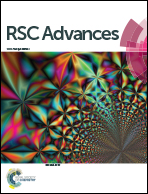Synthesis of two copper clusters and their catalysis towards the oxidation of benzene into phenol†
Abstract
Reaction of a heptadentate ligand (H2LI) and a hexadentate ligand (H2LII) with three equivalents of Cu(ClO4)2·6H2O in methanol under basic conditions afforded a hexanuclear cluster [Cu6(LI)2(OH)4](ClO4)4·2DMF·3Et2O (1) and a nonanuclear cluster [(Cu9(LII)3(OH)7)](ClO4)5·0.25CH3OH·1.15H2O (2), respectively, where H2LI is 2,2′-(((pyridine-2,6-diylbis(methylene))bis((pyridin-2-ylmethyl)azanediyl))bis(methylene))diphenol and H2LII 2,2′-((((5-methyl-1,3-phenylene)bis(methylene))bis((pyridin-2-ylmethyl)azane-diyl))bis(methylene))bis(4-methylphenol). The structures of both clusters in their solid states have been determined by X-ray crystallography. Their magnetic susceptibilities reveal that both clusters are antiferromagnetic due to the coupling between the copper centers in the clusters. NMR spectroscopic analysis, conductivity measurements and ESI-MS analysis suggest that the clusters retain their structural integrities in solution. Both clusters show catalytic activity towards the hydroxylation of benzene into phenol with hydrogen peroxide (H2O2) as an oxidant at 80 °C in aqueous acetonitrile. The conversion rate is about 20% and their TON/TOF are 564/188 and 905/302 for clusters 1 and 2, respectively.


 Please wait while we load your content...
Please wait while we load your content...